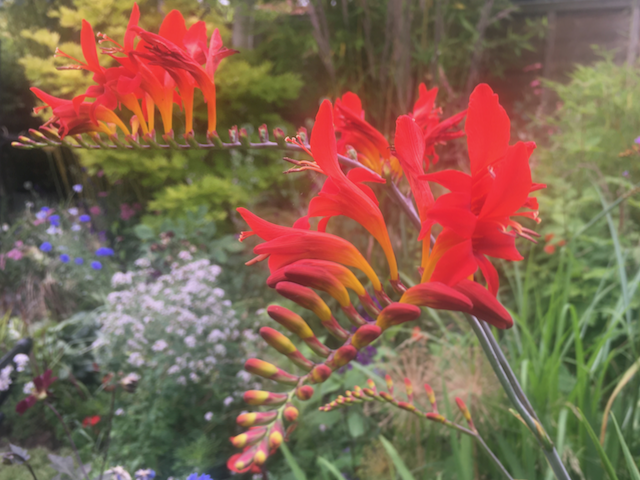Adding an exotic touch to your garden, these arching trumpet-shaped flowers, borne on tall stems appear to float in your border from mid summer to late autumn. Easy to grow, provided some basic rules are followed.
Originating from the grasslands of southern and eastern Africa, Crocosmias are grown worldwide with more than 400 cultivars available. Some however, like Crocosmia × crocosmiiflora, are considered to be invasive in the UK, but if you select the cultivar carefully they will reward you year after year with spectacular blooms.
Growing from underground corms, they produce tall, sword like leaves and arching flower stalks, with trumpet shaped flowers lining up in rows along the stems, opening up in succession from the bottom to the top. Very spectacular.
The corms form vertical chains, with the youngest at the top and oldest and largest buried at the bottom. The roots of the lowermost corm are contractile, dragging the corms deeper into the ground. The chains of corms are fragile and easily separated, a quality that has enabled some species to become difficult to control.
Crocosmia comes from the Greek krokos (saffron) and osme (odour) because the dried flowers smell similar to saffron when steeped in water. Several original species from South Africa were hybridised in the late nineteenth century by the prolific French breeder Victor Lemoine. He created Crocosmia x crocosmiifolia which became known by the somewhat catchier name of Montbretia.
Popular in Victorian times, interest in the plant then faded. Clumps were dug up and discarded, but the corms survived and spread becoming invasive.
However interest was reinvigorated with the development of new cultivars in the 1910’s and then ‘Lucifer‘ by Alan Broom at Bressingham Gardens in the 1960’s.
Crocosmia ‘Lucifer’: probably the most well known cultivar, flowers bright fiery red from early July lasting for 5-8 weeks. Its tall (90-150cm) and vigorous and can produce clumps up to 60cm wide. It’s been given an Award of Garden Merit by the RHS.
Crocosmia ‘Star of the East’: Older than ‘Lucifer’ it was Introduced in 1912 and is still regarded as one of the best cultivars. It produces soft orange 10cm flowers on 120cm stalks.
Crocosmia ‘Carmine Brilliant’: Attractive sprays with 20 or more reddish-pink flowers. The underside of the petal is flushed with scarlet, all held on 70cm purple stems. Smaller clumps can be up to 15cm wide.
Crocosmia ‘Solfatare’: Features sprays of apricot yellow flowers on 70cm stalks. More tender than other cultivars it needs winter protection with a good mulch.
- Select the right position : Whilst they will grow in partial shade, they flower best in full sun.
- Crocosmia do not enjoy hot dry sites, so plant in humus rich, well drained soil.
- Choose a sheltered spot away from cold winds.
- Plant the corms 5-8 cm deep in spring after risk of frost has passed. Space 15-20cm apart if planting in groups. Plant with the ‘pointy’ end of the corm facing up. Water well and apply a mulch to protect the corms in winter.
- Remove spent flowers (cut back stems to where they meet the leaves) to encourage new ones. Water plants well in dry conditions.
- After flowering, allow the leaves to die down naturally before removing.
- Lift and divide clumps every 4 years to maintain vigour.
Crocosmias are generally pest and disease-free but choose varieties wisely – Some varieties can be too vigorous and may become invasive once established. Keep an eye on them and be vigilant – digging up and destroying the corms is the best way to deal with any invasive clumps. This may take several attempts. With careful selection and planting, they are a spectacular addition to any border.

